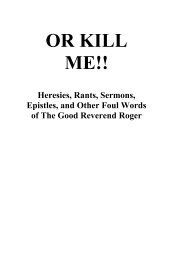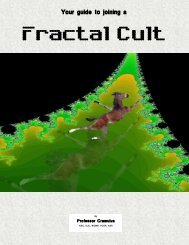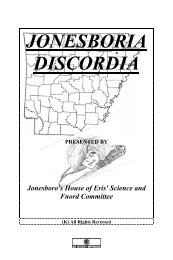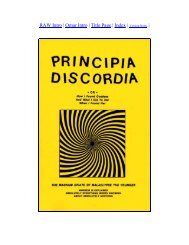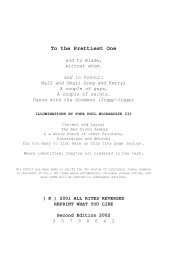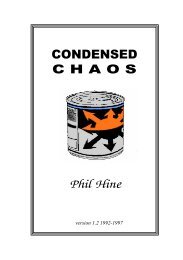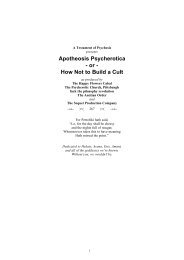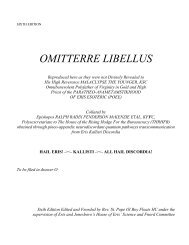Coincidance - Principia Discordia
Coincidance - Principia Discordia
Coincidance - Principia Discordia
Create successful ePaper yourself
Turn your PDF publications into a flip-book with our unique Google optimized e-Paper software.
20 COINCIDANCE<br />
we have seen that Stephen was a magic name to Joyce. St. Stephen is called<br />
Stephen Protomartyr because he was the first Christian martyr; his feast<br />
day is December 26 (the day after Christmas) and in Ireland and England,<br />
rural folk still celebrate the day curiously, by capturing a wren and carrying<br />
it through town singing, "The wren, the wren, the king of all birds / St.<br />
Stephen's day was caught in a furze." The wren is nowadays kept in a cage<br />
and released after the festivity; as recently as the first edition of the Golden<br />
Bough, Frazer reported that the Stone Age custom of killing the wren still<br />
prevailed. When all Dublin turns out to sing a song denouncing Earwicker in<br />
Chapter Two, it is called "the rann, the rann, the king of all verse," with a<br />
pun on the wren sacrifice. (A rann is an ancient Celtic verse-form.)<br />
In Joyce's early short story "Ivy Day in the Committee Room," one of the<br />
characters compares Parnell to the Phoenix, the Egyptian bird of resurrection,<br />
which is said to rise reborn from its own ashes. The equation has become<br />
Phoenix Park = phoenix as symbol of resurrection = Parnell as Crucified<br />
Saviour. What rose from Parnell's martyrdom was the bloody holocaust of<br />
Easter Week 1916, as Irish nationalism reasserted itself more violently than<br />
was the case with Parnell's passive resistance tactics three decades before.<br />
Earwicker was seen by three British soldiers, who are popularly called<br />
"Tommy Atkinses." (This links back to the Tim-Tom-Atum system, of<br />
course.) One of the witnesses against Wilde was a male prostitute named<br />
Fred Atkins. Naturally, FW combines both Tommy and Fred into a<br />
composite Atkins who accuses everybody, and merges with the threatening<br />
figure of the brunette cad, or tramp, or thief, in Phoenix Park. That sinister<br />
composite figure also includes the ancient Celtic bear-god. "What a quhare<br />
soort of a mahan," Earwicker mutters at one point; mahon is Gaelic for bear.<br />
Sometimes this figure becomes Norse playwright Bjorn Bjornssen (whose<br />
works Joyce admired) because Bjorn Bjornssen means "bear bear-son." Puns<br />
on the Latin ursa, bear, also abound, and Glasheen in her Third Census to<br />
Finnegans Wake concludes that the bear-god is one of the major figures in FW.<br />
Weston Lebarre, the anthropologist, in his classic The Ghost Dance: Origins of<br />
Religion (published over 20 years after FW) describes the bear-god as one of<br />
the earliest human divinities and says that if you draw a swath a thousand<br />
miles wide, starting from the Cro-Magnon caves in Southern France and<br />
running up over the North Pole and down through North and South<br />
America, you will find traces of the bear-god cult, at various levels of<br />
persistence, within that whole area. Many of the Eskimo and Amerindian<br />
tribes still celebrate this divinity in ritual, as the Cro-Magnon paintings<br />
suggest our ancestors did; throughout modern Europe remnants of the cult<br />
are found in folk-lore—the talking bears of Norse legend, Goldilocks and the<br />
Three Bears, the children's Teddy Bear totem, etc. The reader will begin to



